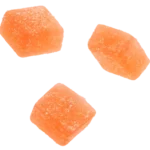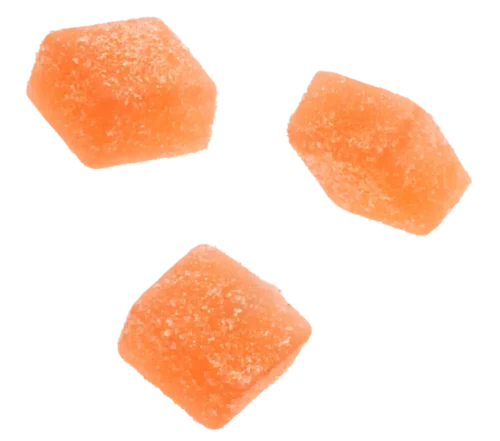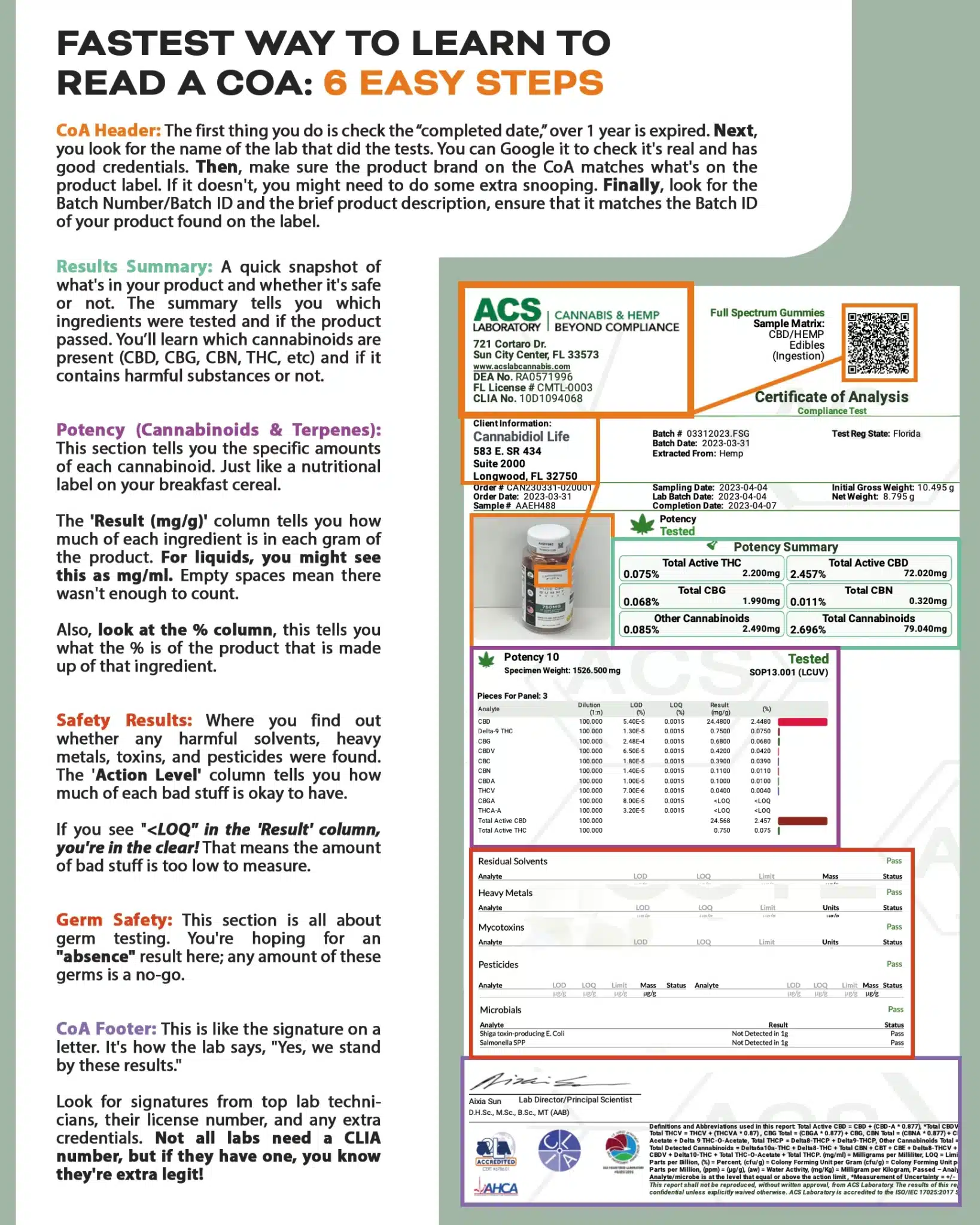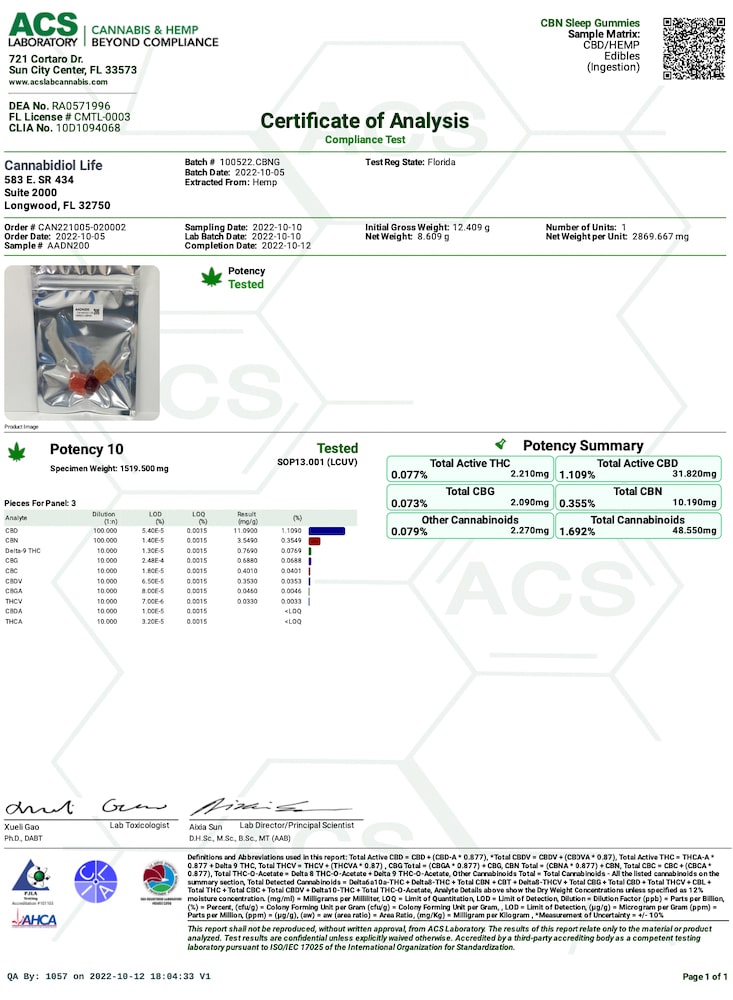Fastest Way To Learn How To Read A COA: 6 Easy Steps


Christopher Visser
Multi-Cannabis Business Owner
Christopher Visser, the Founder and CEO of Cannabidiol Life and THCGummies.com, is a distinguished figure in the CBD industry, recognized for his pioneering contributions since 2016. With over 120 published articles, Christopher has become a reputable cannabis researcher, writer, and author. He's built two prosperous cannabis ventures that collectively generated millions in annual sales. His in-depth analysis of numerous cannabis studies, collaboration with medical professionals, and personal engagement with thousands of customers underline his expertise and commitment to advancing cannabis understanding daily.
-
 Written By:
Christopher Visser
Written By:
Christopher Visser
- Published:
- Updated: February 8, 2024
- Too Quiet, Light Up The Convo!
A COA is not just a piece of paper—it's a statement of integrity, quality, and transparency. Hence, knowing how to read and interpret a COA is crucial for everyone, from manufacturers to consumers. It allows the reader to make informed decisions about the products they are purchasing or using.
Table of Contents
- Tags: How To
A Certificate of Analysis is only as reliable as the laboratory that performs the testing. So, before you just believe any CoA just because it looks official, ensure that the testing facility is accredited and follows good laboratory practices.
Eleyna Smit - Product Manager at Cannabidiol LIfe Tweet
What’s A Certificate of Analysis?
A Certificate of Analysis, commonly referred to as a COA, is a detailed rundown on what’s inside a product used for your assurance that the product you’re buying meets all the necessary legal and safety standards.
If you want to learn about the 13 unique lab tests you could find in a Full Panel Lab Report (COA), along with information on the purpose of each test, why it’s important, and the specific lab technology used to perform each test, you should definitely check out the full article here, “What Is A COA?”
Fastest Way To Learn How To Read A COA: 6 Easy Steps
While the above graphic gives you the entire scope, we’ll dive into the specifics below to ensure complete comprehension.
ImportANT Key Terms & What They Mean
The first step to learning how to read a COA is understanding the important key terms you’ll come across; which are:
- NT
- ND
- <LOQ
- LOD
Let’s break these down as quickly as possible and you can choose how you want to learn them:
DEFINITIONS OF KEY TERMS
#1.
NT = NOT TESTED
‘NT’ on a COA means that a specific test or a unique compound was not tested for.
IMPORTANCE:
If you see ‘NT’ under pesticides or heavy metals, it means these potentially harmful substances weren’t checked for. This ‘NT’ label is the labs way of telling you that they cannot offer you information on the compound its referencing.
#2.
ND = NON-DETECTABLE
‘ND,’ short for ‘Non-Detectable’ or ‘Not Detected.’
IMPORTANCE:
This label could be considered good news if its used next to contaminants like microbial or myotoxin, but it could also be sad if its used next to a cannabinoid you were hoping your product had an abundance of.
#3.
<LOQ = Less Than Limit of Quantitation
‘<LOQ’ on a Certificate of Analysis means that the substance is present, but in such small quantities that it’s “below the limit of quantification.” In other words, it’s present, but there’s so little it can’t be measured accurately.
#4.
LOD = Limit of Detection
The LOD is the smallest amount of a substance that a lab’s equipment can detect. This does not infer that the substance can be measured, it just means it can be detected. For it to be accurately measurable, it must be present at levels that reach the LOQ mark.
Explanation Of Key Terms In Story Form

SCENARIO:
Imagine you’ve been instructed to test four pitch black rooms inside a house. Your job is to search each room for any instances of light coming in. If you find any evidence of light, you must measure it’s luminosity (brightness of a light).
Room #1 (NT):
You go to enter the dark bedroom, but the door is locked! Since the room is not testable, it would be marked as NT (Not Tested).
Room #2 (ND):
You enter and begin searching the dark room for any sign of light. Unfortunately, no light was ever found. In this instance, you’d mark this room as ND (Not Detected).
Room #3 (LOD):
In this room, you notice a very faint glimmer of light coming from a gap in the floorboards. It’s so faint that you can’t be sure if it’s actually light or if your eyes are playing tricks on you. But since your mission is to report any evidence of light, no matter how uncertain, you record that there was a potential detection of light, albeit below the level that could be confidently identified or measured. This situation illustrates the concept of LOD (Limit of Detection). It’s like saying, “There might be some light here, but it’s so faint that I can’t tell for sure.”
Room #4 (LOQ):
In your final room, you find a thin beam of light sneaking in through a crack in the door. While it’s faint, you can see it consistently enough to verify that it’s indeed light and not just a figment of your imagination. However, the light is so dim that when you try to measure its brightness with your luminosity meter, the readings fluctuate too much to give a reliable measurement. You can definitely say light is present, but its brightness is below the level that your tool can reliably quantify. This represents the LOQ (Limit of Quantification). It’s like saying, “I can definitely see some light here, but it’s too faint for me to measure its brightness accurately.”
So, there you have it, your mini-dictionary in story-form for decoding a COA!
How To ReaD A Cannabinoid Potency COA (INTERACTIVE)
Click on a hotspot below to learn more about the information found on cannabinoid potency Certificate of Analysis. This analysis is also referred to as a “Compliance Test” because it is aimed at verifying that the product is within the federal legal limits containing <0.3% Delta-9 THC. For more info on what makes an edible federally legal, see our article on, How To Buy Edibles Online, LEGALLY.
Why Learning To Read A COA Is So Important
It’s important to be able to understand a Certificate of Analysis because it tells you directly whether a cannabis product is safe for consumption. If you haven’t got on board with wanting to view COAs, you may way to begin; over 60% of consumers check a product’s COA before making a purchase.
Besides the above findings, there are a few very important reasons why learning to read a COA is vital, they are as followed:
- Consumer health & safety
- Product authenticity & advertising consistency
+ verifying accuracy of ‘full spectrum’ products - Compliance with local laws and federal regulations
+ Likelihood the product will show up on a drug test
Consumer Health & Safety
The bitterness of poor quality remains long after the sweetness of low price is forgotten.
Benjamin Franklin Tweet
Mr. Franklin speaks truth. Quality is everything, your health and safety depends on it. CoAs provide detailed information about any potential contaminants in the product, such as pesticides, heavy metals, microbial impurities, mycotoxins, and residual solvents, which are all crucial for ensuring the safety of the consumer. Additionally, the CoA may list non-cannabinoid ingredients, such as carrier oils, flavors, or other additives, which is vital information for consumers with allergies or sensitivities.
Product Authenticity & Advertising Consistency
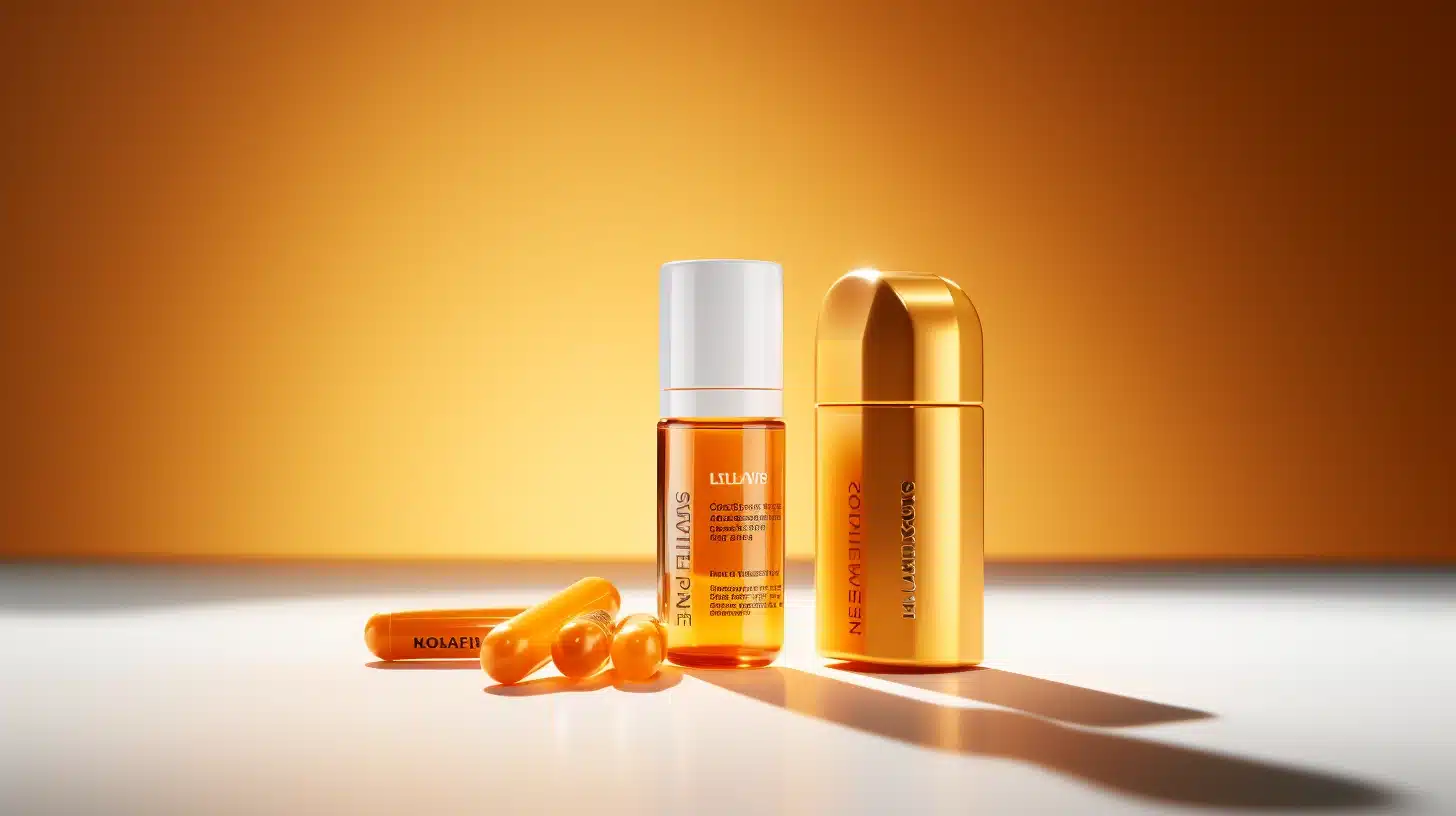
A CoA verifies the exact levels of cannabinoids present in the product, confirming that it contains the advertised amount of THC, CBD, and other cannabinoids. By comparing CoAs from batch to batch, consumers can assess the consistency of the product’s cannabinoid and terpene profiles.
While this issue was brought up years ago in a study by The Journal of American Medicine Association, it seems that a lot of bad companies in the CBD industry are still really bad at ensuring that the cannabinoids within the product they’re selling, matches what they market on the product label.
In a recent study published on August 3, 2023 in the UK, only 8% (out of 63 different products tested) had cannabinoid concentrations within 10% of what they advertised the strength to be. The remaining 92% of products were below the advertised cannabinoid concentrations.
Myself, have being in the Cannabis industry since 2016, and having completed hundreds of COAs for our products over the years, I can tell you directly that this eight percentage of accuracy is mind-boggling! It is not that difficult. Further, the study gives a 10% buffer to be considered accurate... fines should be implemented to further protect retail buyers.
Christopher Visser - CEO of Cannabidiol Life & THCGummies.com Tweet
People believe and trust product label advertisements. This is shown via another consumer research study that stated that the majority of consumers believe that the CBD product they’re buying contains the equivalent amount that is advertised on the label.
Verifying accuracy of 'Full Spectrum' products
Understanding COAs gives you the ability to tell whether a product is a TRUE full spectrum product or not. The realism within the cannabis industry is that a lot of products found on the market are labeled as full spectrum products, but they’re just not.
If you know how to read a COA, you’ll be able to see how many different cannabinoids were detected. If you notice that only 2-4 cannabinoids were detectable out of the standard 11 cannabinoids from a compliance test, or the 20 cannabinoids tested for in the more robust full panel tests, this is your indentier that the product is way closer to being categorized as a broad-spectrum product than full spectrum.
Quality is not an act, it is a habit.
- Aristotle Tweet
IMPORTANCE: Due to the Entourage Effect, Broad Spectrum products are considered to be not as effective as full-spectrum products. So, if a product is labeled as full-spectrum, there is absolutely heightened value due to greater products efficacy.
Compliance with Local Laws and Federal Regulations

One main reason is that it helps you ensure you’re abiding by both local and federal laws. How so? Well, laws often depend on specific concentrations of certain compounds, like delta-9 THC. For example, in the U.S., federal law says hemp products can’t have more than 0.3% delta-9 THC. With a COA in hand, you can check the THC level and know whether you’re in the clear or stepping over the legal limit.
Likelihood the product will show up on a drug test
Additionally, a COA can give you a heads-up if a product might show up on a drug test. Drug tests typically screen for THC, the compound that gives cannabis its famous high. So, if you need to pass a drug test for work or other reasons, you’ll want to look at the COA’s info on delta-9 THC. If it’s more than trace amounts, the product might lead to a positive drug test. Knowing this, you can make an informed decision and choose a product that suits your specific needs and circumstances.
Closing Remarks
In closing, a Certificate of Analysis (CoA) is a fundamental document that verifies the quality, safety, and authenticity of cannabis products. While it may initially appear complex, understanding a CoA isn’t as difficult as it might seem, once you get to grips with key terms such as NT, ND, LOQ, and LOD. Importantly, a CoA reveals whether a product has been properly tested for harmful substances, and also verifies the exact levels of cannabinoids, ensuring the product aligns with what’s advertised.
Moreover, learning to read a CoA enables consumers to determine whether a product is a genuine full-spectrum one, contributing to its potential effectiveness. Lastly, it assists in compliance with local and federal laws, and indicates the likelihood of a product showing up on a drug test. So, if you’re in the cannabis market, familiarize yourself with CoAs for your safety, peace of mind, and to ensure you’re getting what you paid for. Knowledge is indeed power, and in this case, it could be a matter of your health and wellbeing.

If this article sparked a new insight, pass the flame…
LET’S IGNITE RIPPLES OF CANNABIS WISDOM.
Be the catalyst for someone’s breakthrough moment.
SHARE ON SOCIAL MEDIA

YOUR CANNABIS EDIBLE
JOURNEY CONTINUES:
Looking For Something Else?

